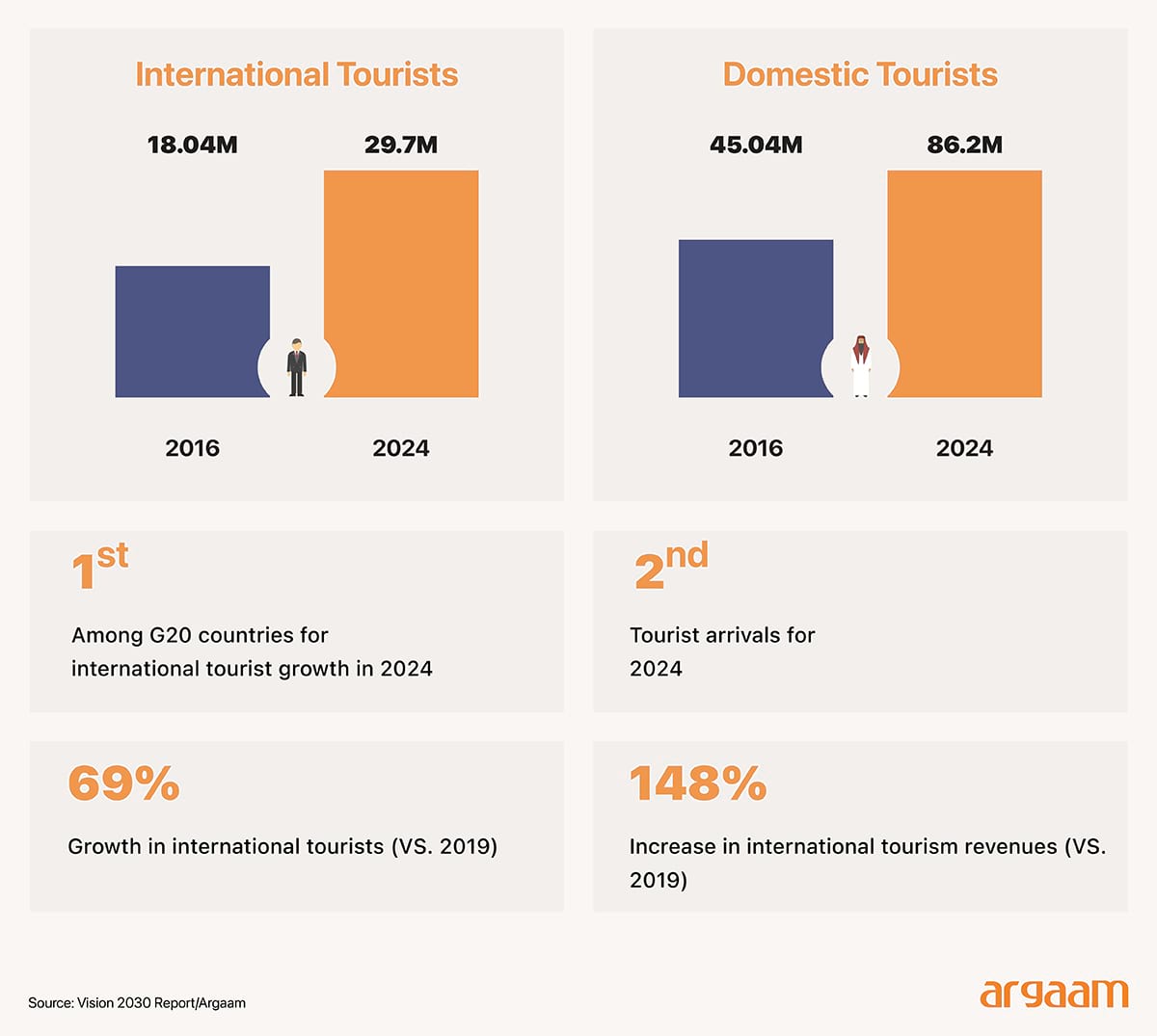|
The recent employment data from Saudi Arabia highlight a dynamic and evolving economic landscape with significant job creation in the tourism sector compared to other vital sectors chiefly manufacturing, and technology. In 2024, the tourism sector created employed a total of 966.5 thousand individuals, significantly outpacing the manufacturing sector's 44,000 new jobs and the IT sector’s 9,348 jobs. Over the past five years, tourism-related employment has grown considerably to nearly 2.7 million jobs, with Riyadh and Makkah Al Mukrammah serving as pivotal centers for this growth. Meanwhile, the manufacturing sector has generated approximately 420,000 new jobs between 2020 and early 2025. While these figures underscore the tremendous success of tourism development initiatives, especially in job creation, it is important to recognize in this analysis the challenges of managing sectoral employment imbalances in a way that supports sustainable economic growth. This observation in our analysis does not diminish the importance or potential of the tourism sector in job creation; rather, it underscores the value of a multi-sectoral employment strategy to avoid symptoms similar to ‘the Dutch disease’. From the perspective of exponential growth of a sector, the Dutch disease in economics can be defined as a phenomenon where rapid expansion in one particular sector leads to resource allocation and economic imbalances that come at the expense of other vital sectors. So the overall economic growth could become disproportionate over the long-term as key factors like labor, investments and capital have been shifting towards the booming sector. Consequently, the overall economic structure becomes less diversified. An overreliance on one sector, in this case the tourism sector, might inadvertently contribute to resource reallocation away from manufacturing and IT sectors, which are vital for enhancing productivity, technological advancement, and long-term economic resilience. 
Overview of the tourism sector
In 2024, Saudi Arabia's tourism sector significantly contributed to the country's GDP with 4.7%. The sector injected SAR 447.2 billion (approximately $131.9 billion ) into the economy. This contribution is expected to continue growing, with projections indicating a potential increase to 10% of GDP by 2030. The 2024 tourism data for Saudi Arabia reveals a robust domestic tourism market that significantly surpasses international arrivals. With 86.3 million domestic tourists compared to 29.7 million international visitors, domestic tourism accounts for approximately 74.4% of the total tourism activity. That said, the number of international tourists increased from approximately 18 million in 2016 to nearly 30 million by 2024. This growth can be attributed to several factors, including a new legal and digital framework, including the National Tourism Strategy, e-visa rollout, and the updated Tourism Law. But more importantly, the societal shifts in recent years play a critical role in enhancing Saudi Arabia’s appeal to international visitors. 
Saudi Arabia has been actively re-defining the concept of tourism since the launch of Vision 2030 by creating diverse tourism offerings. The kingdom’s tourism sector is no longer associated with only religious tourism represented in the annual Hajj and Umrah. Today, the tourism re-definition targets different tourist categories to cater to varied interests and demographic profiles. The Kingdom offers luxury resorts aimed at attracting affluent domestic and international tourists, while simultaneously developing family-oriented destinations that emphasize safety, cultural values, and essential services to appeal to domestic and regional visitors. Furthermore, Saudi Arabia promotes visits to historical and heritage sites to attract foreign tourists in particular, who are interested in history. According to the recently published Vision 2030 report, the original target to double the number of Saudi sites on the UNESCO World Heritage List has already been achieved. In 2023, "The Cultural Landscape of Al-Faw Archaeological Area" became the Kingdom’s eighth listed site, meeting the 2030 target ahead of schedule. 
Towards high-quality employment growth
It is important to recognize certain structural characteristics commonly associated with tourism employment globally, including the tendency for a significant portion of jobs to be lower-paid. This is often due to the labor-intensive nature of many tourism-related activities, which, while essential, may not always offer rapid opportunities for skill development or wage progression in the long term for Saudi nationals. Additionally, slower productivity growth in tourism compared to sectors like manufacturing or IT can imply that, over time, the tourism sector alone may have limitations as a foundation for sustainable, high-quality employment growth for Saudi nationals. Slower productivity growth in tourism means that the rate at which the output (goods or services) per unit of input (such as labor or capital) increases over time is lower in the tourism sector compared to sectors like manufacturing or IT. In other words, tourism does not improve efficiency or generate more value per worker as quickly as these other sectors. Manufacturing and IT industries generally require substantial investment not only in machinery, technology, and infrastructure but also in developing a skilled and well-educated workforce. While these sectors may create fewer jobs compared to more labor-intensive sectors like tourism, the opportunities they offer tend to demand higher levels of education and technical expertise, supporting long-term economic growth and workforce development. There is a risk that an overemphasis on tourism may inadvertently reduce incentives for pursuing higher education and advanced skills among the Saudi workforce. Over time, this could lead to a generation of workers who may find their career options more limited as they advance in age, potentially experiencing “career fatigue” and wishing they had invested more in educational development. In conclusion, encouraging sustainable tourism growth while simultaneously nurturing non-tourism sectors can prevent potential overheating in any single industry, reduce vulnerability to geopolitical shocks especially in tourism, and improve the economy’s capacity for inclusive growth. In the next edition, we will explore why it is crucial for Saudi Arabia to develop a thriving domestic community of data scientists and AI researchers. Building strong local talent will empower the Kingdom to innovate, lead, and compete on the global AI stage. |
|
|
|
|
|






